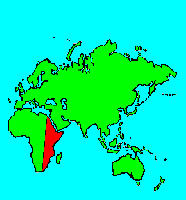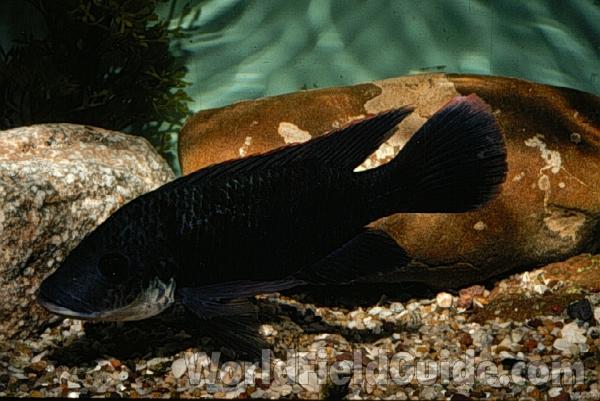SPECIES INFO
Black chin tilapia (Tilapia melanotheron to Sarotherodon melantheron) is native to western Africa. It can be found from Liberia south to Cameroon. This tilapia can grow to about 10 inches in length. Blackchin mouthbreeder is a candidate for commerical fisheries. This species has now escaped in Florida in North America.Tilapia genus contains about 75 species of fresh and brackish fish species native to Africa. Several subgenera including Sarotherodon and Oreochromis have been introduced into the nomenclature. Some members of this genus can weigh up to 20 pounds. Many species of Tilapia have been widely introduced around the world.
Members of this genus have served human food needs since the time of the early Egyptians. Today, many researchers believe members of this genus can help solve the need for protein for the over populated world. Raising tilapia is not an easy occupation, as they can over populate a pond, and stunt the entire population. Some breeders now employ fish sorters to weed out the females to help this breeding process produce better crop yields. Migdalski estimates that yields (we presume per year) of 2 tons per acre are possible. Many grocery stores in North America now carry Tilapia.
Tilapia mossambica (to perhaps Sarotherodon mossambica) was introduced into Java prior to World War II, and today Javan Tilapia is helping feed the orient. This species is now considered established in North America in at least California and Texas. Tilapia melanotheron is now established in Florida.
Robert Rush Miller observes that Tilapia are an important economic feature of Mexico, but he also notes that Tilapia will certainly have an impact on many endangered and rare species.
African Cichlids have been separated from the South American Cichlids to facilitate study of this large family. There are numerous species in this family in the various freshwater lakes in the interior of Africa. The largest African cichlid at about 36 inches can be found in Lake Tanganyika.
The number of different species of African cichlids found in each of three Africa lakes is very high. In their book on freshwater aquairum fish Burgess-Axelrod note the following:
Lake Malawi - 250 species of cichlids
Lake Tanganyika - 175 cichlid species.
Lake Victoria - 40 cichlid species.
They additionally make the observation that new species are still being added to the above totals.
Cichlidae group of African and South American freshwater fish are a favorite with tropical fish fanciers because of their many nice colors. This is a very large family with numerous species.
To facilitate study of this family, we have divided the Cichlidae into sections based on the geographical origin of the species. This helps somewhat, but one must remember that quite a few of the species have been introduced beyond their native continents.
Perch-like Fish, Order Perciformes, are the largest order of fish in both freshwater and shallow saltwater. Most of the conventional fish belong to this order. The bass, bluegills, perch and crappies of freshwater plus the groupers and sea bass of salt water belong to this order. The fish all have spiny rays in their fins and the tail fin has seventeen rays. There are approximately 150 families. Herein, we have placed the families in alphabetical sequence within this order. (In some instances the typical taxonomic sequence of families is not much help. Consider, for example, that the barracudas are usually placed between the mullets and the threadfins.)
Bony fish, Class Teleostomi, are a class of chordates that include the majority of fish-like animals found on earth. They are characterized by a bony jaw and a bony skeleton. They are found in both fresh and marine waters.
Backboned Animals (Phylum Chordata) are the most advanced group of animals on earth. These animals are characterized by having a spinal cord or backbone. Most members have a clearly defined brain that controls the organism through a spinal cord. Fish, amphibians, reptiles, birds, and mammals are in this phylum.
Currently, some taxonomists believe that the fish should be divided into two groups (sharks and regular fishes) and that there are some other primitive groups in the phylum such as hagfish or lampreys.
Animal Kingdom contains numerous organisms that feed on other animals or plants. Included in the animal kingdom are the lower marine invertebrates such as sponges and corals, the jointed legged animals such as insects and spiders, and the backboned animals such as fish, amphibians, reptiles, birds, and mammals.


